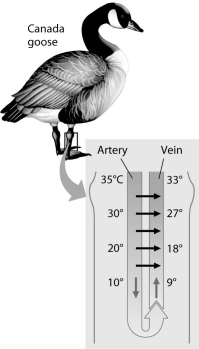Multiple Choice

-The thin horizontal arrows in the figure above show that
A) the warmer arterial blood can bypass the legs as needed, when the legs are too cold to function well.
B) the warmer venous blood transfers heat to the cooler arterial blood.
C) the warmer arterial blood transfers heat to the cooler venous blood.
D) the arterial blood is always cooler in the abdomen, compared to the temperature of the venous blood in the feet of the goose.
E) the goose's legs get progressively warmer as the blood moves away from the abdomen to the feet.
Correct Answer:

Verified
Correct Answer:
Verified
Q41: If you gently twist your earlobe, it
Q42: Humans can lose, but cannot gain, heat
Q43: Among these choices, the least reliable indicator
Q44: Interstitial fluid is<br>A) the fluid inside the
Q45: Tissues are composed of cells, and tissues
Q47: Muscles are joined to bones by<br>A) ligaments.<br>B)
Q48: Fibroblasts secrete<br>A) fats.<br>B) chondroitin sulfate.<br>C) interstitial fluids.<br>D)
Q49: Connective tissues typically have<br>A) many densely packed
Q50: Of the following choices, the epithelium with
Q51: Hibernation and estivation during seasons of environmental